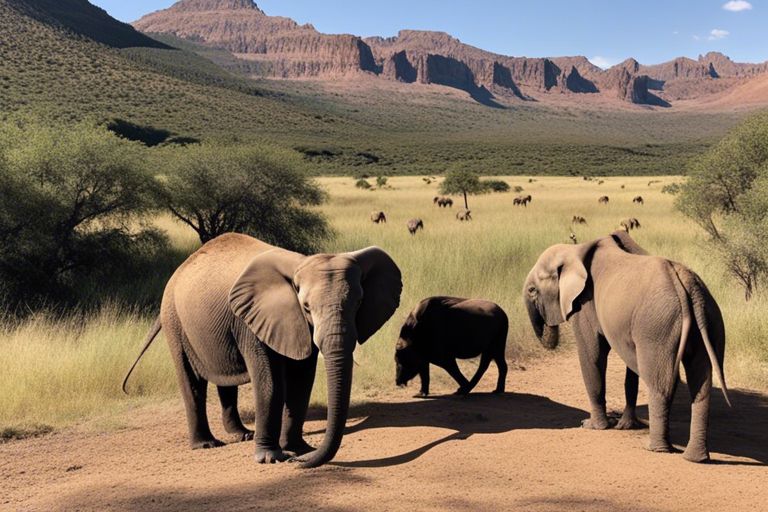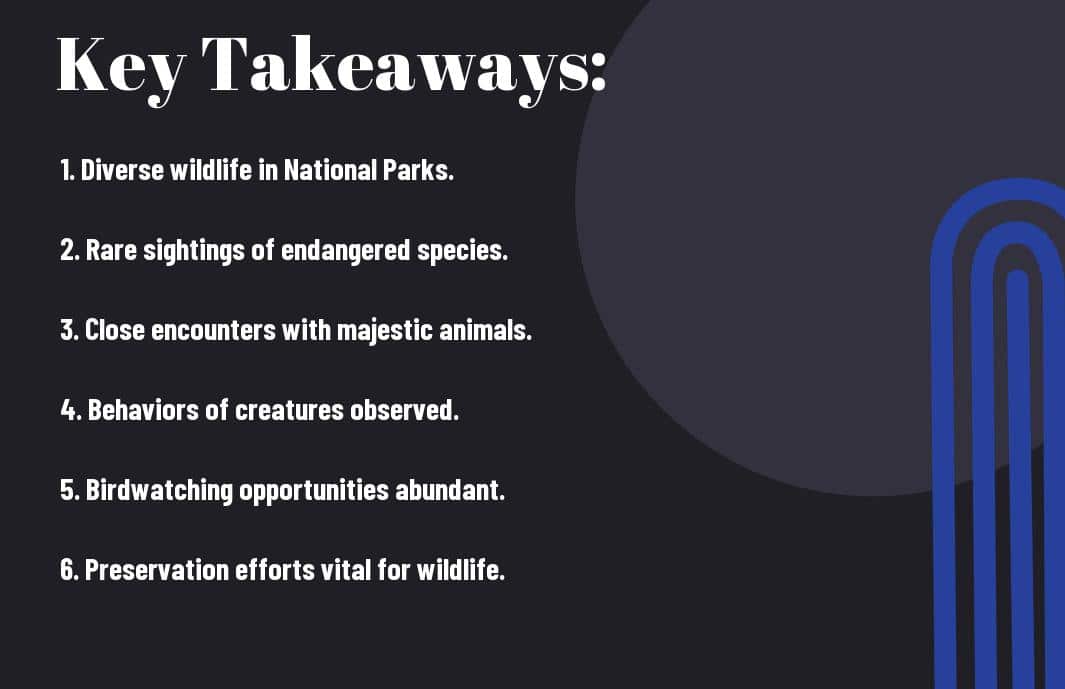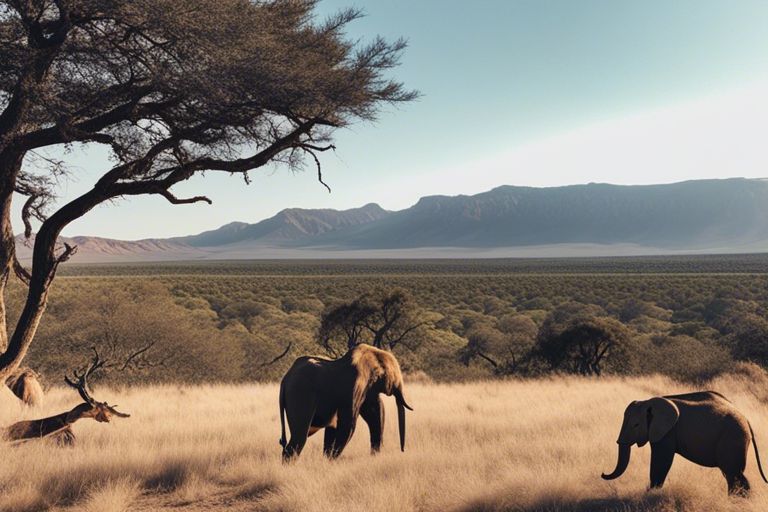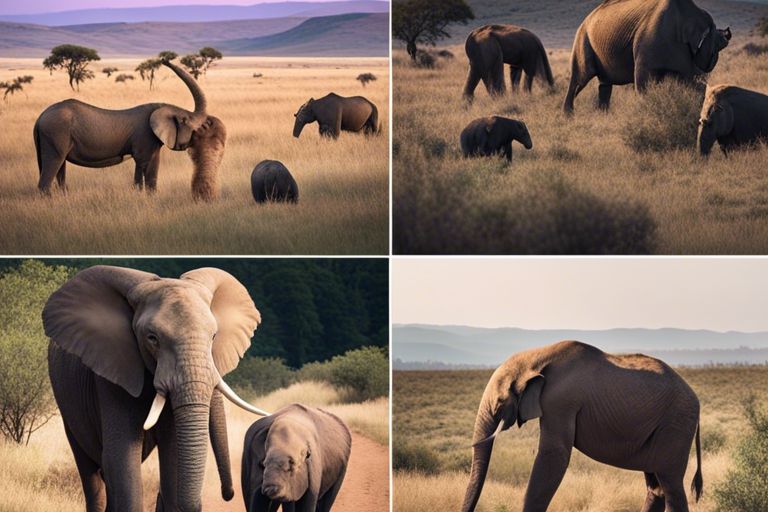Just imagine being surrounded by the most diverse and breathtaking wildlife in the world within the confines of National Parks. From the majestic grizzly bears of Yellowstone to the elusive jaguars of the Amazon Rainforest, these protected areas are home to some of the most incredible creatures on Earth. Join us as we explore the thrill of wildlife watching in National Parks and uncover the beauty and danger of encountering these magnificent animals in their natural habitats.
Key Takeaways:
- Bison in Yellowstone: Witness the iconic American bison roaming freely in Yellowstone National Park.
- Grizzly Bears in Denali: Experience the thrill of spotting majestic grizzly bears in Denali National Park.
- Elk in Rocky Mountain: Encounter the elegant elk in their natural habitat at Rocky Mountain National Park.
- Whale Watching in Olympic: Enjoy the breathtaking sight of whales swimming off the coast of Olympic National Park.
- Manatees in Everglades: Get a chance to see gentle manatees gliding through the waters of Everglades National Park.
- Wolves in Yellowstone: Watch the elusive wolves hunting and playing in the wilderness of Yellowstone National Park.
- Bald Eagles in Acadia: Marvel at the sight of bald eagles soaring high above the landscapes of Acadia National Park.
Preparing for Your Wildlife Watching Adventure
Essential Gear and Equipment
Watching wildlife in national parks can be an exhilarating experience, but it requires proper gear and equipment. Essential items to pack include binoculars for spotting animals from a distance, a camera to capture those special moments, comfortable clothing and sturdy footwear for long hikes through the wilderness, a field guide to help with animal identification, and a reusable water bottle to stay hydrated during your adventure.
Ethical Wildlife Watching Practices
For ethical wildlife watching practices, it is crucial to remember that you are a visitor in their home. Respect the animals’ space by keeping a safe distance and never approaching or feeding them. Avoid making loud noises or sudden movements that could disturb or stress the wildlife. Additionally, be mindful of your impact on the environment by following designated trails and properly disposing of waste. Recall, the goal is to observe these incredible creatures without causing them any harm.
National Park Wildlife Highlights by Region
North American Marvels
All wildlife enthusiasts must experience the North American marvels found in the national parks of the United States and Canada. One can witness the majestic grizzly bears of Yellowstone National Park, the playful sea otters off the coast of Olympic National Park, and the elusive wolves of Banff National Park. These iconic species represent just a fraction of the diverse wildlife that calls North America home.
Exotic Species of Africa and Asia
To truly immerse oneself in the world of wildlife, exploring the exotic species of Africa and Asia in national parks is a must. From the powerful elephants of Kruger National Park to the graceful tigers of Ranthambore National Park, these regions offer a glimpse into some of the most awe-inspiring creatures on the planet.
Exotic species such as the endangered mountain gorillas of Virunga National Park in Africa and the rare snow leopards of Hemis National Park in Asia showcase the rare beauty and fragility of these ecosystems. These species are not only awe-inspiring but also serve as critical indicators of the overall health of the regions they inhabit.
Seasonal Wildlife Events in National Parks
Migration Patterns and Prime Viewing Times
Now, Parks across the country offer unique opportunities to witness the great wildlife migrations that occur annually. From the majestic monarch butterflies to the awe-inspiring wildebeest herds, these migrations bring a sense of wonder and amazement to all who witness them. The prime viewing times for these migrations vary depending on the species, but visitors can typically plan their trips around these natural spectacles to witness nature’s incredible journey.
Breeding and Nesting Seasons to Observe
Nesting is an necessary part of the wildlife cycle, providing a safe space for young animals to grow and thrive. National parks offer an ideal setting to observe breeding and nesting behaviors up close. During these seasons, visitors have the opportunity to witness animals such as birds, sea turtles, and even some mammals caring for their young. Whether it’s the melodious songs of nesting birds or the heartwarming sight of a mother tending to her newborn, these moments offer a glimpse into the intimate lives of wildlife.
Breeding seasons provide a unique window into the courtship rituals and behaviors of animals as they seek to perpetuate their species. It is a time of intense competition and displays of strength and prowess as males vie for the attention of females. Visitors should exercise caution during these times, as some species may exhibit aggressive behavior to protect their territory or young. Witnessing these breeding behaviors can be both thrilling and educational, offering a deeper appreciation for the intricacies of the natural world.
Enhancing Your Wildlife Watching Experience
Guided Tours vs. Independent Exploration
On a guided tour, you can benefit from the expertise of professional naturalists who can help you spot elusive wildlife and provide valuable insights. They are trained to enhance your experience by sharing interesting facts and ensuring your safety. However, if you prefer more flexibility and solitude, independent exploration allows you to set your own pace and immerse yourself in the natural surroundings without any time constraints.
Photography and Field Notes: Documenting Your Encounters
Encounters with wildlife can be fleeting, so capturing the moment through photography and field notes can help you preserve these memories for years to come. Photographs also serve as a valuable tool for identification and research purposes. Taking notes on behavior, habitat, and other observations can deepen your understanding of the creatures you encounter.
Understanding the importance of keeping a safe distance from wildlife is crucial to both your safety and the well-being of the animals. Respecting their natural habitat and not interfering with their behavior are necessary principles to follow when documenting your encounters. By approaching with caution and observing from a distance, you can enjoy a rewarding wildlife watching experience while minimizing any negative impact.
Conclusion
The breathtaking diversity of wildlife found in national parks around the world highlights the importance of conservation efforts to protect these incredible creatures. From majestic elephants roaming the savannas of Africa to elusive snow leopards prowling the mountains of Asia, there is so much to see and learn from these amazing animals. By supporting ecotourism and responsible wildlife watching practices, we can help ensure that future generations can continue to marvel at the beauty and wonder of these national park treasures.
FAQ
Q: What are some of the most amazing creatures you can see while wildlife watching in national parks?
A: You can see a wide variety of incredible creatures while wildlife watching in national parks, including grizzly bears, bald eagles, wolves, elk, bison, mountain lions, and many more.
Q: Where are the best national parks to go wildlife watching?
A: Some of the best national parks for wildlife watching include Yellowstone National Park, Grand Teton National Park, Denali National Park, Everglades National Park, and Rocky Mountain National Park.
Q: What should I bring with me when going wildlife watching in national parks?
A: When going wildlife watching in national parks, it is important to bring binoculars, a camera with a telephoto lens, comfortable walking shoes, layered clothing, a field guide to local wildlife, snacks, water, and a map of the park.




